American Journal of Plant Sciences
Vol. 4 No. 2 (2013) , Article ID: 28362 , 9 pages DOI:10.4236/ajps.2013.42045
Root Characters of Maize as Influenced by Drip Fertigation Levels
![]()
Department of Agronomy, Tamil Nadu Agricultural University, Tamil Nadu, India.
Email: fanish_agri@yahoo.co.in
Received October 10th, 2012; revised November 13th, 2012; accepted November 20th, 2012
Keywords: Drip Fertigation; Maize Based Intercropping System; Root Spread; Root Dry Weight
ABSTRACT
The efficient use of water by modern irrigation systems is becoming increasingly important in arid and semi-arid regions with limited water resources. Field experiments were conducted during 2008-2010 to study the effect of drip fertigation with water soluble fertilizer on root growth of maize under maize based intercropping system. The experiment was laid out in strip plot design with three replications. The treatment consists of nine fertigation levels in main plots and four inter crops in sub plots. Root spread and root dry mass were increased under drip fertigation practices while rooting depth was more under surface irrigation. Drip fertigation with water soluble fertilizer improved the root system by inducing new secondary roots which are succulent and actively involved in physiological responses. Drip fertigation has pronounced effect on the root architecture especially in the production of highly fibrous root system.
1. Introduction
The sustainability of any production system requires optimum utilization of resources be it water, fertilizer or soil. Because of its highly localized application and the flexibility in scheduling water and chemical applications, drip irrigation has gained widespread popularity as an efficient and economically viable method for fertigation. Drip irrigation with fertigation offers a vast potential for optimum utilization of water and fertilizers [1,2]. Application of fertilizers through an efficient irrigation system, known as fertigation, results in more accurate and timely crop nutrition, thus, leading to increased yield besides considerable savings in fertilizers [3]. Fertilizers applied under traditional methods are generally not utilized efficiently by the crop. In fertigation, nutrients are applied through emitters directly into the zone of maximum root activity and consequently fertilizer-use efficiency can be improved over conventional method of fertilizer application. Generally crop response to fertilizer application through drip irrigation has been excellent and frequent nutrient applications have improved the fertilizer-use efficiency [4]. The crop response to fertilizer applications is expected to vary markedly with the type of fertilizer used.
Intercropping, the growing of two or more crop species simultaneously in the same field during a growing season is important for the development of sustainable food production systems, particularly in cropping systems with limited external inputs. This may be due to some of the potential benefits for intercropping system such as high productivity and profitability, improvement of soil fertility, efficient use of resources, risk minimizetion, efficient use of labour, reducing damage caused by pests, diseases and weeds, erosion control and food security [5,6]. Further, when the intercrop provides a good soil cover, soil temperature will stay relatively low. This prevents burning of the organic matter in the soil and loss of nutrients. It also provides a microclimate that can be favourable for associated crops. Selection of appropriate and compatible component crops for intercropping helps in reducing interand intra-plant competition for resources, thereby enhancing the productivity with optimal use of available and applied resources. Due to ever increasing human population especially in India leading diminishing land sizes, intercropping, with its advantages of risk minimization, reduction of soil erosion, increased food security should be practiced.
India ranks second (next only to China) in the production of vegetables contributing to 12 per cent of world production. But the production (87 mt) and consumption (145 g/head/day) are rather low and inadequate to meet the unfulfilled demand (230 g/head/day) of vegetables of rising population in the country with practically no scope for horizontal expansion of the area under cultivation. The crop intensification in the form of inter and multiple cropping provides greater opportunity for enhancing the production per unit area and time. Apart from encouraging large scale cultivation of vegetables in general, technology also needs to be generated to include vegetables in the cropping systems particularly in an intercropping system with regular crops. This will not only go a long way in augmenting vegetable production in the country but also helps in efficient utilization of natural and scarce resources namely land and water. Maize is one such crop which provides opportunity for inclusion of intercrop, the wide row space provided to the crop and also because of the plasticity of the crop to row spacing. In recent years, vegetables are grown as intercrops for higher income by the farmers of India. Vegetables such as beet root, onion, cabbage, cucumber, radish, snap bean, and broccoli are intercropped into double rows of field maize planted on raised soil beds. In intercropping systems with different canopy heights the crop in the under story needs to be shade tolerant for the plant to be productive [7].
Maize has three possible uses viz., food, feed for livestock and raw material for industry. Maize grown in subsistence agriculture continues to be a basic food crop. In recent years, in developing countries like India maize is becoming a commercial crop due to its high demand as an animal feed ingredient. Among the different factors influencing the productivity of maize, water and nutrients occupy prime position. Maize crop responds very well to water and nutrient application. Maize is one of the amenable crops for drip irrigation system, which is an efficient method of irrigation [8]. Many scientists reported enhanced growth and development of maize under drip irrigation [9,10]. Maize is a nutrient loving crop, which pumps out more quantity of nutrients from soil.
Inter-row space in maize during the initial slow growth period provides ample scope to cultivate the compatible crop in between two rows of maize and increase the productivity per unit area and time. Performance of radish and beetroot [11-13], coriander [14] and onion [15] as with maize are well documented. These systems would provide early, periodic and high economic return besides ensuring stability. Productivity of the system can be enhanced by judicious selection of vegetable crops differing in duration, canopy architecture and growth rhythum so as to adjust the demands of the above and underground resource like light, moisture and nutrient during different growth stages.
In spite of having many economic and other advantages over the method of flood irrigation, the coverage of area under micro-irrigation is not appreciable in India. Among the various reasons for the slow progress of adoption of this new technology, its capital-intensive nature seems to be one of the main deterrent factors. The drip system installed for maize crop can be used for intercrops too simultaneously and helps to reduce the payback period and increase the income. A vegetable crop fetches higher market values than agricultural field crops in shorter period. Inclusion of vegetable crops in wide spaced field crops under drip irrigation helps to gets more remuneration within shorter period.
Research works on drip irrigation under intercropping situation is very limited. Input information on optimal schedules for micro-irrigation and fertigation to maize and planting geometry for micro-irrigation will have to be generated from the current levels thus enabling the option of micro-irrigation under intercropping situation. Therefore, the present investigation was conducted to study the effect of fertigation involving the source and rate of fertilizers, methods of fertilizer application like through soil and drip irrigation on maize under different intercropping situation
2. Materials and Methods
2.1. Seasons and Weather Data
Field experiments were conducted at the Department of Agronomy, Agricultural College and Research Institute, Coimbatore, India from 2008 (winter) until 2009 (winter). The region is characterized as semi-arid tropical (SAT) climate, located at 11˚8'N latitude and 77˚8'E longitude. The mean annual rainfall (83 years) at Coimbatore is 674 mm distributed over about 50 rainy days with a 30% annual coefficient of variation. The rainfall is monsoon type, with a south-west monsoon from June to September and a north-east monsoon from October to December. The mean annual maximum and minimum temperature ranged from 29.2˚C to 35.2˚C and from 17.9˚C to 23.8˚C, respectively. The mean relative humidity ranged from 50 to 77 percent. The mean pan evaporation per day ranged from 3.1 to 6.7 mm.
The field was uniformly levelled and formed into raised flat beds for maize. The lateral spacing between two raised flat beds was 1.5 m with furrow in-between of 30 cm width and 15 cm depth. In the surface irrigated plots, ridges and furrows were formed at 60 cm apart. Maize along with intercrops viz., radish, beetroot, onion and vegetable coriander were raised during winter (August, 2008-November, 2008) under raised bed lay out of drip system. A confirmation study with the same set of treatments was conducted in the same seasons during 2009. The pre-sowing composite soil samples collected from the experimental soil was analyzed for physicalchemical characteristics. The experimental soil was sandy clay with 1.36 - 1.42 (2008) and 1.34 - 1.41 (2009) g·cc−1 of bulk density, field capacity of 25.2% - 26.3% (2008) and 25.1% - 26.1% (2009), and permanent wilting point of 12.5% - 13.7% (2008) and 12.4% - 13.6% (2009). The nutrient status was low (216 - 220 kg·ha−1), medium (16 - 17 kg·ha−1) and high (425 - 428 kg·ha−1) for available nitrogen (N), phosphorus (P) and potassium (K), respectively.
Maize crop along with intercrops were raised during first year in winter (August 2008-November 2008) received 437 mm of rainfall in 26 rainy days (Table 1). Weekly mean pan evaporation ranged from 3.6 to 9.6 mm per day. Maximum mean weekly temperature was 31.5˚C and minimum was 21.8˚C. Relative humidity ranged between 67% and 98% and 41% and 71% at 07:22 and 14:22 h, respectively.
Maize crop along with intercrops were raised during second year in winter (July 2009 to October 2009) received 188 mm of rainfall in 22 rainy days. Weekly mean pan evaporation ranged from 3.9 to 6.6 mm per day. Maximum mean weekly temperature was 28.71˚C - 36.2˚C and minimum was 17.1˚C - 22.6˚C. Relative humidity ranged between 76% to 94% and 38% to 71% at 07:22 and 14:22 h, respectively.
2.2. Lay Out and Experimentation
The experiment was laid out in strip plot design with three replications. The treatment consists of nine fertigation levels in main plots and four inter crops in sub plots. The treatments were allotted to the plots by randomization. Recommended dose of fertilizer were 150:75:75 kg NPK·ha−1. Treatments are as follow
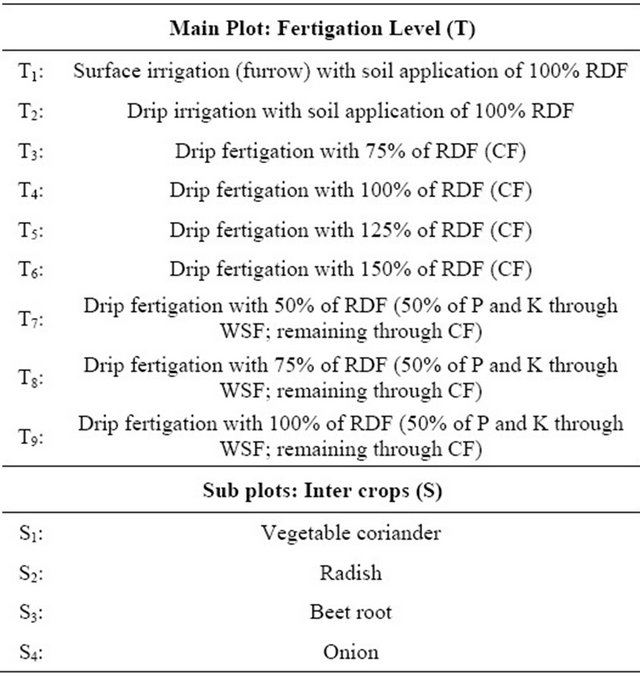
RDF: Recommended Dose of Fertilizer; WSF: Water Soluble Fertilizer; CF: Conventional Fertilizer.
The experimental field was ploughed with tractor drawn disc plough followed by two ploughings with cultivator and the clods were broken with rotavator. The field was uniformly levelled and raised flat beds were formed in the dimension of 120 cm width, 30 cm furrow and 15 cm height. The lateral spacing between two raised flat beds was 1.5 m. In the surface irrigated plots, ridges and furrows were formed at 60 cm apart. Buffer channels were formed to control the lateral seepage of water from one plot to another.
In surface irrigation treatment, maize was sown at a spacing of 60 × 20 cm. Paired row planting system was adopted under drip irrigation with a spacing of 75 × 20 cm. In between the two rows of maize two rows of inter crops were sown by adopting a spacing of 30 cm between rows. The planting patterns under surface and drip irrigation are given in Figure 1.
Good quality seeds of maize, radish, beetroot coriander and onion bulbs were used for the experimental study. All seeds were placed by hand dibbling with specified spacing. Sowing irrigation was uniformly given to all treatments. The drip irrigation scheduling was done based on wetted area concept and irrigation system was operated once in three days.

Table 1. Seasonal rainfall distribution.
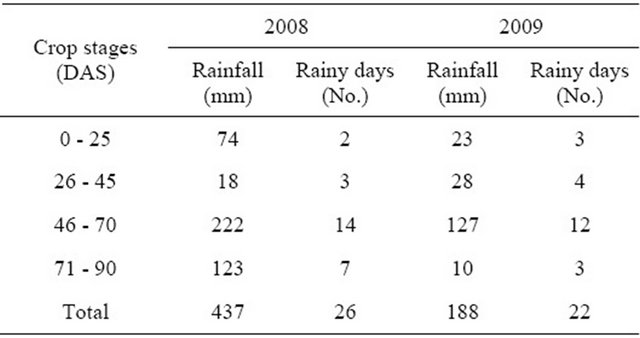
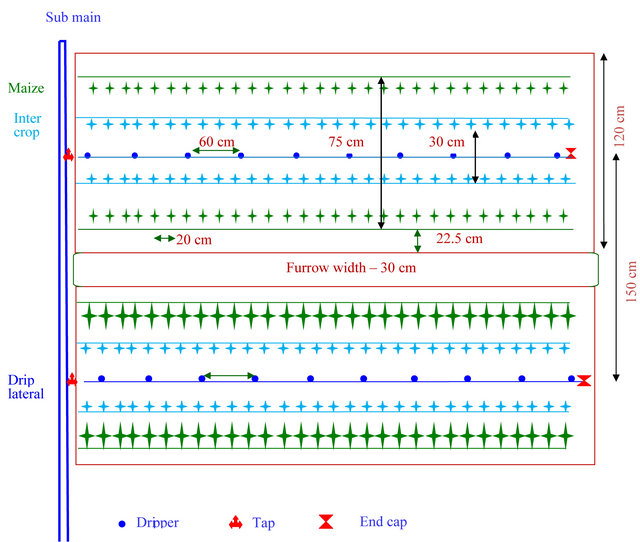
Figure 1. Layout of individual plot for maize based intercropping system.
where, ETc, crop evapotranspiration; CPE, cumulative pan evaporation (mm); Kp, pan factor (0.8); Kc, crop coefficient; Wp, wetting area percentage (80%); S, crop spacing (0.60 m × 0.20 m for maize).
Irrigation water was pumped through electric motor and conveyed to the main line of 63 mm OD (outer diameter) PVC (poly vinyl chloride) pipes after filtering through sand filter. In the main line, venturi was installed for fertigation. From the main, sub mains of 40 mm OD PVC pipes were drawn and from the sub-main, laterals of 12 mm LLDPE (low linear density polyethylene) pipes were installed at an interval of 1.5 m. Each lateral was provided with individual tap control for imposing respective irrigation schedules. Along the laterals, inline drippers with a discharge capacity of 4 lph were spaced at 0.6 m. Sub-mains and laterals were closed at the end with end cap. After installation, trial run was conducted to assess mean dripper discharge and uniformity coefficient. This was taken into account while fixing the irrigation water application time. During the irrigation period an average of 90% - 95% uniformity was observed. The tabulated Kc values were adjusted according to the local climatic conditions (Table 2). Furrow irrigation was applied based on IW/CPE (IW = irrigation water; CPE = cumulative pan evaporation) ratio of 0.80. The depth of irrigation was fixed as 5 cm per irrigation.
The quantity of irrigation water supplied through drip was 173 (2008) and 198 (2009) and the effective rainfall received during the cropping period was 158 mm (2008) and 130 mm (2009). The total water used under the drip irrigation treatments was 331 mm and 328 mm during 2008 and 2009, respectively. Under furrow irrigation method, irrigation was given immediately after sowing followed by life irrigation at 5 cm depth thereafter irrigation was given as per the IW/CPE ratio of 0.8. Quantity of water applied was 300 and 350 mm during winter 2008 and winter 2009, respectively. An effective rainfall of 192 and 161 mm was received during crop period and totally 492 and 511 mm of water was consumed by surface irrigated crop.
Healthy crop stand was ensured by adopting recommended package of practices and need based plant protection measures. Recommended dose of 150:75:75 kg of NPK·ha−1 were applied to maize.
Table 2. Kc values.

The recommended doses of inorganic fertilizers were applied directly to soil for the treatments T1 and T2. Fertilizer sources used for supplying NPK were urea (46% N), di ammonium phosphate (18% N and 46% P2O5) and muriate of potash (60% K2O) respectively. The entire quantity of phosphorus was applied as basal in treatments T1 to T6 in the form of di ammonium phosphate one day before sowing. In the treatments T1 and T2 involving soil application of fertilizers, recommended dose of nitrogen and potassium were applied in the form of urea in three splits (basal, 25 DAS and 45 DAS) and muriate of potash in two splits.
2.3. Fertigation
For treatments T3 to T9, fertilizers were given through drip fertigation. In treatments T3 to T6 normal fertilizer was used as sources for supplying NPK through drip irrigation. Normal fertilizers viz., urea and muriate of potash were used to supply N and K respectively. For the treatments T7 to T9 50 per cent P and K were supplied through water soluble fertilizer and remaining through normal fertilizer. Mono ammonium phosphate (12:61:0) and multi-K (13:0:46) were used as water soluble fertileizer for supplying P and K respectively. The fertilizer solution was prepared by dissolving the required quantity of fertilizer with water in 1:5 ratio and injected into the irrigation system through ventury assembly. Considering the nutrient uptake pattern at phenological growth phases of maize, the fertigation schedule was worked out and presented in Table 3.
2.4. Observation
Soil moisture content was estimated by gravimetric method. Soil samples were taken at a spacing of 0, 10, 20 and 30 cm between lateral and 10, 20 and 30 cm between dripper at a depth of 0 - 10, 10 - 20, 20 - 30, 30 - 40 and 40 - 50 cm for studying soil moisture distribution pattern in each drip irrigation regime. This observation was made in rain free periods. Data were collected before start of the irrigation from two plants in each treatment
Table 3. Fertigation schedule for maize.
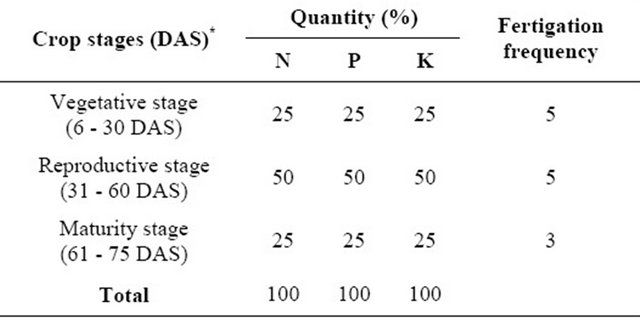
*DAS: Days after Sowing.
and the average values were expressed in % soil moisture by oven dry weight. Since the same trend was observed in both the years of the study, mean data for soil moisture content at different locations before irrigation was arrived and depicted as graphical representation. Graphical software package SURFER was used to show the three dimensional view of soil moisture distribution vertically and horizontally from the emitter.
The root studies were made by measuring the tap root (rooting depth), root volume and root dry mass (g) at crop maturity stage in three tagged plants and mean value was arrived. Root characters were assessed by modified trench method as suggested by Bohm [16]. Trenches to a convenient depth and sufficient length on both sides of the sampling row were opened by digging with fork without snatching the root lets and separated away from the sampling rows. The plants were carefully excavated until the tip of each plant root was just visible. The soil adhering to the plant was carefully removed by immersing in water tub and the soil was disintegrated and then observations were made. Rooting depth was measured from the collar region to tip of the deepest root and expressed in cm. Root samples were air dried initially followed by oven drying at 65˚C ± 5˚C till a constant weight is attained and root mass was expressed as g per plant.
2.5. Statistical Analysis
The data pertained to root characters were subjected to statistical analysis by Analysis of Variance (ANOVA) using AGRES (Data Entry Module for AgRes Statistical software version 3.01, 1994 Pascal Intl. Software Solutions). Differences between means were evaluated for significance using least significant differences (LSD) at 5% probability level as suggested by [17].
3. Results and Discussion
3.1. Rooting Depth
Roots are the main component in absorption of water and minerals, which are essential in plant physiological processes.
Maize root went deeper in soil profile under surface irrigation for want of water and registered more rooting depth. The rooting depth of maize at different fertigation levels and intercrops varied widely as presented in Table 4. Data collected at harvet stage showed that surface irrigation recorded significantly higher values for rooting depth (45.04 and 47.34 cm during 2008 and 2009, respectively). Rooting depth was increased as water stress increased.
Among the different fertigation treatments, drip fertigation at 100 per cent RDF with 50 per cent P and K as WSF produced lengthier roots (57.16 and 53.43 cm during 2008 and 2009, respectively) than other treatments.
Regarding intercropping system, maize + vegetable coriander recorded a higher rooting depth (54.54 and 51.19 cm in 2008 and 2009 respectively) of maize followed by maize + onion.
Interaction effect between fertigation level and intercrops was found to be non significant for rooting depth of maize.
3.2. Root Spread
Root spread of maize was significantly affected by the drip fertigation levels and intercrops (Table 5). Lateral root spread was more under drip fertigation of 100 per cent RDF with 50 per cent P and K as WSF (T9) (44.59 and 42.29 cm respectively, during 2008 and 2009) followed by fertigation at 150 per cent RDF (T6). In contrast to rooting depth, very short and thin lateral roots were found in surface irrigated plants (T1). Similar trend was noticed during both the years of experimentation.
Root system was manifested favorably under drip fertigation with water soluble fertilizer with good rooting depth, spread and dry weight when compared to surface irrigation. Water stress under surface irrigation increased the rooting depth to obtain water from the deep soil. If roots were unable to find the water in later stages also, stress made it to loose its succulence and became insensitive to moisture deficit then leads to degrade. Under surface irrigation treatments roots have gone to deeper layers for want of water as evidenced by higher values for rooting depth than others. However, if water is unavailable in deeper soil in later stages, degradation of root will occur. In this experiment also degradation of roots for both lateral and vertical direction at wetting front was observed under surface irrigation treatments and reflected in root spread. Kang [18] and Pandey [19] expressed the similar views on maize root development under water stress conditions.
Among the intercrops, vegetable coriander as intercrop system produced more maize root spread (42.69 cm) followed by onion as intercrop system (41.06 cm during 2008). The lesser root spread of maize was observed under beet root as intercrop (39.03 cm) system. The same trend was observed in second year also.
3.3. Root Dry Weight
The root dry mass recorded at harvest stage of maize was significantly influenced by the drip fertigation and intecrops during both years (Table 6). Higher values (17.8 and 17.9 g, respectively during 2007 and 2008) for root dry mass were recorded under drip fertigation of 100 per cent RDF with 50 per cent P and K as WSF (T9) (43.1 and 42.3 cm respectively, during 2008 and 2009) followed by fertigation at 150 per cent RDF (T6). Water
Table 4. Effect of drip fertigation levels and inter crops on rooting depth of maize.
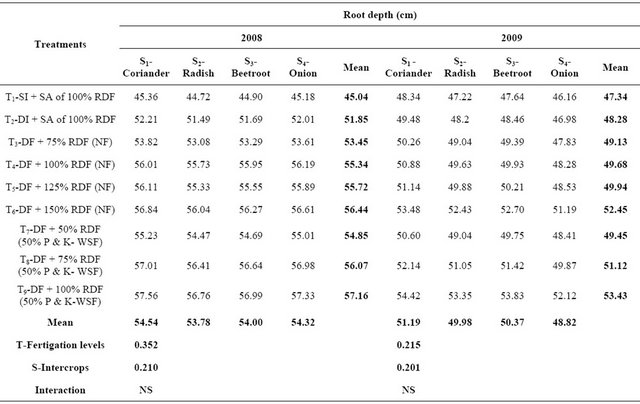
Table 5. Effect of drip fertigation levels and inter crops on root spread of maize.
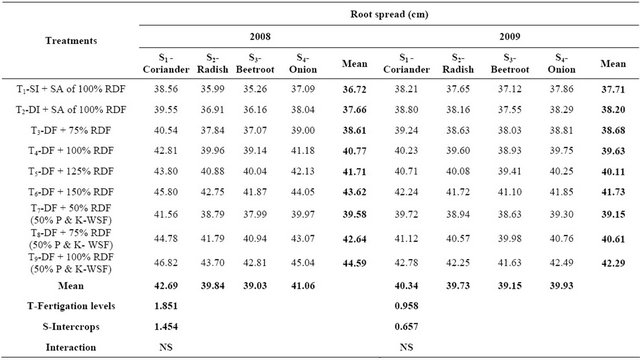
stress under surface irrigation (T1) significantly reduced the root dry mass recorded significantly least values (15.4 and 15.7 g, respectively during 2008 and 2009) when compared to other treatments.
Table 6. Effect of drip fertigation levels and inter crops on root dry weight of maize.
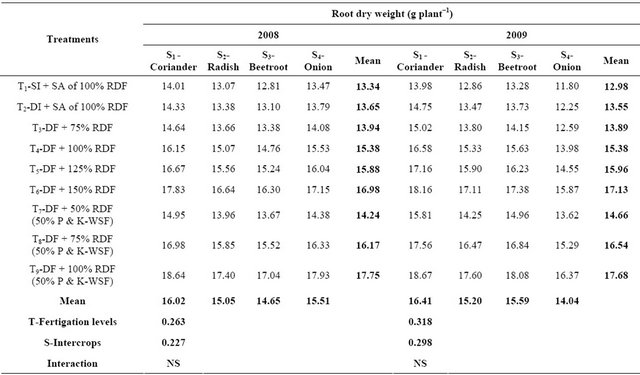
Surface irrigated plants (T1) produced longer but thinner roots compared to drip irrigated plant. Preferential partitioning of photosynthates to leaf area expansion at the expense of root growth may have been responsible for the lower root dry mass at water stress compared with fully irrigated roots [20]. The same effect of water stress on root dry mass was observed in this study also.
Drip fertigated maize had a higher root biomass than surface irrigated crop. Drip fertigation levels exerted significant influence on root biomass. Drip fertigation with 100 per cent RDF in which 50 per cent P and K through WSF produced greater root biomass of 17.75 and 17.68 g plant−1 during 2008 and 2009, respectively. Lowest root biomass of 13.34 (2008) and 12.98 (2009) g plant−1 was observed under surface irrigation with soil application of fertilizer. The root biomass was significantly influenced by the intercrops at harvest stage of maize. Vegetable coriander as intercrop recorded more root biomass of maize (16.02 and 16.41 g plant−1 during 2008 and 2009, respectively)
3.4. Influence of Drip Fertigation Levels and Intercrops on Root Characters
Plant roots play a vital role in soil water and solute dynamics by modifying the water and solute uptake patterns in the rooting zone [21,22]. At early stages of crop growth, the better availability of nitrogen could have helped to build up sufficient framework. Under trickle fertigation with surface wetting, the production of lengthier roots clearly indicated that the plant tried hard to extract available water from deeper layers to meet its water requirements. This was in conformity with the findings of Kataria and Michael [23]. Growth of the root, in general, is stimulated by phosphorus and applied P which would have encouraged the early root growth. Similar results were also reported by [24,25].
The root characters like root length, root spread and root dry weight were significantly affected by fertigation levels in all the intercropping systems. The root system is the link between the plant and soil. It is responsible for the absorption of water and nutrients, anchorage, synthesis of some plant harmones and storage [26]. In order to achieve proper growth, the root zone of a plant must be well supplied with both water and oxygen. Among the fertigation treatments, 150 per cent RDF and 100 per cent RDF with P and K as WSF resulted in higher root parameters. Adequate quantity of nutrients coupled with adequate moisture might have resulted in higher root proliferation. Application of readily available form of fertilizer particularly in frequent intervals (once in three days) by reducing the quantity of nutrients at one application, the crops could able to utilize maximum quantity of nutrients reducing the leaching and volatilization loss and increasing the nutrient use efficiency which might have resulted in higher root growth. This showed positive response of root characters to higher fertilizer dose producing higher root biomass under favourable moisture and nutrient status as observed by Parthasarathi [27] in radish. Fertigation enhanced overall root activity; improve the mobility of nutritive elements and their uptake, as well as reducing the contamination of surface and ground water [28].
Under surface application of fertilizer with drip irrigation, nearly 75 per cent of total fertilizers were applied as basal, due to which the crop could not able to absorb all the nutrients at a single time and the unutilized nutrients were either fixed in the soil or leached away from the root zone. So the fertilizer use efficiency was low and the uptake also low which might have resulted in lower root growth. Concentration of root biomass was maximum (0 - 30 cm) in the upper soil profile under drip irrigation system compared to surface irrigation.
Under surface fertilized plots, the entire quantity of P (75 kg·ha−1) was applied as basal on the day of sowing, where the P gets fixed up in the soil profile and when the roots emerge and grows, it was able to utilize the available P alone which are very low due to fixation in the soil. Whereas under drip fertigation (T7 to T9 treatments), the P nutrient in the form of mono ammonium phosphate which is easily soluble in water was fertigated from 7th day after sowing and fertigated once in three days up to 75 days. So the crop was able to absorb more P throughout the crop growth period with very minimum loss of nutrients. This might be the reason for higher root growth under drip fertigated treatments when compared to surface applied plots.
Concentration of roots were maximum in the upper soil profile under drip irrigation system, while in surface irrigation, the tap root length was more but the root biomass was less. This was due to the fact that the moisture was fast depleting beyond the root zone and the plants had to extract water from deeper layers.
There was significant response on root character (rooting depth, root volume and root biomass) of maize crop due to intercropping system. Root growth was higher under maize + vegetable coriander intercropping system. Radish, beet root and onion were root crops. The growths of below ground part of these crops affect the growth of root of maize crop. This might be the reason for higher root growth of maize under maize + vegetable coriander.
4. Conclusion
Fertigation levels and intercrops had significant impact on root system of maize. Root spread and root dry mass were increased under drip fertigation practices while rooting depth was more under surface irrigation. Drip fertigation with water soluble fertilizer improved the root system by inducing new secondary roots which are succulent and actively involved in physiological responses. Drip fertigation has pronounced effect on the root architecture especially in the production of highly fibrous root system. Fertigation promotes the production of intensely branched roots that facilitates nutrient acquisition and foraging capacity. On the other hand, conventional method of irrigation and fertilizer application has exhibited limited root spread in the rhizosphere. Regarding intercropping system, maize + vegetable coriander recorded higher root characters.
REFERENCES
- J. N. Raina, B. C. Thakur and M. L. Verma, “Effect of Drip Irrigation and Polyethylene Mulch on Yield, Quality and Water-Use Efficiency of Tomato,” The Indian Journal of Agricultural Sciences, Vol. 69, No. 6, 1999, pp. 430-433
- J. N. Raina, “Drip Irrigation and Fertigation: Prospects and Retrospect’s in Temperate Fruit Production,” In: K. K. Jindal and D. R. Gautam Eds., Enhancement of Temperate Fruit Production in Changing Climate, UHF, Solan, 2002, pp. 296-301.
- C. Bussi, J. G. Huguet and H. Defrance, “Fertilization Scheduling in Peach Orchard under Trickle Irrigation,” Journal of Horticulture Science, Vol. 66, No. 4, 1991, pp. 487- 493.
- R. S. Malik, K. Kumar and A. R. Bhandari, ”Effect of Urea Application through Drip Irrigation System on Nitrate Distribution in Loamy Sand Soils and Pea Yield,” Journal of the Indian Society of Soil Science, Vol. 42, No. 1, 1994, pp. 6-10.
- P. Banik, A. Midya, B. K. Sarkar and S. S. Ghose, “Wheat and Chickpea Intercropping Systems in an Additive Series Experiment: Advantages and Weed Smothering,” European Journal of Agronomy, Vol. 24, No. 4, 2006, pp. 325-332. doi:10.1016/j.eja.2005.10.010
- P. K. Ghosh, M. Mohanty, K. K. Bandyopadhyay, D. K. Painuli and A. K. Misra, “Growth, Competition, Yields Advantage and Economics in Soybean/Pigeonpea Intercropping System in Semi-Arid Tropics of India II. Effect of Nutrient Management,” Field Crops Research, Vol. 96, No. 1, 2006, pp. 90-97. doi:10.1016/j.fcr.2005.05.010
- J. M. Sogbedji, H. M. Van, J. R. R. Melkonian and R. R. Schindelbeck, “Evaluation of the P. N. M. Model for Simulating Drain Flow Nitrate-N Concentration under Manure Fertilized Maize,” Plant and Soil, Vol. 282, 2006, pp. 343-360.
- C. Zhu, S. Naqvi, S. Gomez-Galera, A. M. Pelacho, T. Capell and P. Christou, “Transgenic Strategies for the Nutritional Enhancement of Plants,” Trends in Plant Science, Vol. 12, No. 12, 2007, pp. 548-555. doi:10.1016/j.tplants.2007.09.007
- F. R. Lamm, T. P. Trooin, H. L. Manges and H. D. Sunderman, “Nitrogen Fertilization for Subsurface Drip-Fertigated Corn,” Transactions of the American Society of Agricultural Engineers, Vol. 44, No. 3, 2001, pp. 533-542.
- K. Mmolawa and D. Or, “Root Zone Solute Dynamics under Drip Irrigation: A Review,” Plant and Soil, Vol. 222, No. 1-2, 2000, pp. 163-190. doi:10.1023/A:1004756832038
- M. T. Reddy, S. Ismail and Y. N. Reddy, “Performance of Radish (Raphanus sativus L.) under Graded Levels of Nitrogen in Ber-Based Intercropping,” Journal of Research ANGRAU, Vol. 27, No. 3, 2001, pp. 24-28.
- S. N. Singh and A. Kumar, “Production Potential and Economics of Winter D1aize Based Intercropping Systems,” Annals of Agricultural Research, Vol. 23, No. 4, 2002, pp. 532-534.
- R. A. Kumar, K. Chillar and R. C. Gautam, “Nutrient Requirement of Winter Maize (Zea mays)-Based Intercropping Systems,” Indian Joumal of Agricultural Sciences, Vol. 76, No. 5, 2006, pp. 315-318.
- N. Chellaiah, U. Solaiappan and S. Senthilvel, “Effect of Sowing Time and Intercropping on the Yield of Coriander under Rainfed Condition,” Madras Agricultural Journal, Vol. 88, No. 10-12, 2002, pp. 684-689.
- M. Mahadevaswamy, “Studies on Intercropping of Aggregated Onion (Allium cepa var. Aggregatum) in Wide Spaced Sugarcane,” Ph.D. Thesis, TNAU, Coimbatore, 2001.
- W. Bohm, H. Maduakor and H. M. Taylor, “Comparison of Five Methods for Characterizing Soybean Rooting Density and Development,” Agronomy Journal, Vol. 69, No. 3, 1977, pp. 415-419. doi:10.2134/agronj1977.00021962006900030021x
- K. A. Gomez and A. A. Gomez, “Statistical Procedures for Agricultural Research,” 2nd Edition, John Wiley and Sons, New York, 1984, p. 680.
- S. Kang, W. Shi and J. Zhang, “An Improved Water-Use Efficiency for Maize Grown under Regulated Deficit Irrogation,” Field Crops Research, Vol. 67, No. 3, 2000, pp. 207-214. doi:10.1016/S0378-4290(00)00095-2
- V. K. Pandey, J. P. Bharat and H. D. Bagde, “Water Requirement of Bitter Gourd under Pressurised Irrigation System,” Journal of Indian Water Resource Society, Vol. 28, No. 2, 2009, pp. 15-19.
- M. Pace, J. J. Cole, S. R. Carpenter and J. F. Kitchell, “Trophic Cascades Revealed in Diverse Ecosystems,” Trends in Ecology & Evolution, Vol. 14, No. 12, 1999, pp. 483-488. doi:10.1016/S0169-5347(99)01723-1
- K. Mmolawa and D. Or, “Root Zone Solute Dynamics under Drip Irrigation: A Review,” Plant and Soil, Vol. 222, No. 1-2, 2000, pp. 163-190. doi:10.1023/A:1004756832038
- T. Selvakumar, “Performance Evaluation of Drip Fertigation on Growth, Yield and Water Use in Hybrid Chilli (Capsicum annuum L.),” Ph.D. Thesis, TNAU, Coimbatore, 2006.
- D. P. Kataria and A. M. Michael, “Comparative Study of Drip and Furrow Methods,” Proceedings of XI International Congress on the Use of Plastic in Agriculture, New Delhi, 26 February-2 March 1990, pp. 19-27.
- S. U. Ahmed and H. K. Saha, “Effect of Different Levels of N, P and K on the Growth and Yield of Four Tomato Varieties,” Punjab Vegetable Growers, Vol. 21, 1986, pp. 16-19.
- S. Kang, W. Shi and J. Zhang, “An Improved Water-Use Efficiency for Maize Grown under Regulated Deficit Irrogation,” Field Crops Research, Vol. 67, No. 3, 2000, pp. 207-214. doi:10.1016/S0378-4290(00)00095-2
- E. Lahav and D. W. Turner, “Banana Nutrition,” International Potash Institute Bulletin, Vol. 7, 1989, p. 33.
- K. S. Parthasarathi, M. Krishnappa, N. C. Gowda, S. Reddy and M. Anjanappa, “Growth and Yield of Certain Radish Varieties to Varying Level of Fertility,” Karnataka Journal of Agricultural Sciences, Vol. 12, No. 1-4, 1999, pp. 148-153.
- M. H. Taha, “Chemical Fertilizers and Irrigation System in Egypt,” Proceedings of the FAO Regional Workshop on Guidelines for Efficient Fertilizers Use through Irrigation, Cario, 14-16 December 1999.

